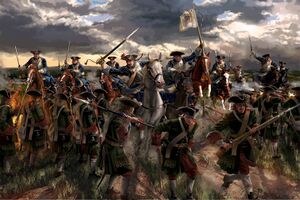Battle of Jefford's Junction
| Battle of Jefford's Junction | |||||||
|---|---|---|---|---|---|---|---|
| Part of the Aquitaynian War of Independence | |||||||
 Imperial Guard cavalry slam into Aswickian lines | |||||||
| |||||||
| Belligerents | |||||||
|
|
| ||||||
| Commanders and leaders | |||||||
| Col. Joseph Mercer | Castus Tamphilus | ||||||
| Strength | |||||||
| 1,550 | 1,300 | ||||||
| Casualties and losses | |||||||
|
611 115 captured Total: 1147 |
551 wounded 14 missing Total:901 | ||||||
The Battle of Jefford's Junction was fought on October 3, 1741, between forces of the Empire of Exponent's Imperial Guard Corp and the Royal Aswickan Army. The Imperial forces were successful in clearing the Aswickans from the field, but the battle severely mauled the Imperial Guards, causing them to withdraw from combat for the remainder of the campaign.
Background
After the loss of Jamestown, the Aswickan Army under the command of General Alexander Jones was on the march to their winter encampment when the Imperial forces caught up. Colonel Mercer's forces were detached from the main force under orders to delay the Imperials by whatever means necessary so that the main force could get away.
Battle
Forming of the lines and initial advance
Colonel Joseph Mercer, commanding the Aswickan forces defending the road junction, deliberately chose for a defensive strategy. The terrain was advantageous to his forces, and gave clear sight to the battery of 4 12-pounder guns he had available to him. His forces consisted mostly of local Militia, though he was able to bring along 3 Companies of his own Regiment of regulars.
Imperial forces initially formed up in a line opposing the Aswickan troops just out of range of the Aswickan artillery. As the began advancing, however, the cannons quickly began firing at the Imperial formation. At some point, quite quickly on, a stray shot flew through the General's group and barely missed Legate Tamphilus, killing two members of his staff and wounding another. [1]
Having closed the distance between the two lines by half, Imperial forces then began taking fire from Aswickan irregular forces: Riflemen and skirmishers had positioned themselves in a slight ditch between the two formations. Though they could not do much, they did harass the Imperials with the rifles, which had a higher range than the Imperials' muskets. The irregulars specifically targeted Imperial officers and non-commissioned officers in an effort to cause disarray in their ranks while performing a fighting retreat to stay out of the ever advancing Imperials.
Decimation of the Imperial Guard
By the time the Imperial Guard their ranks were already showing signs of fatigue and loss of cohesion. Yet, faced with the punishment they would face if they failed in their task, they chose to press on until they came into range of the Aswickan line. The Aswickans, though largely untrained in line warfare, were able to get quick shots off at the Imperial Guards. The two lines exchanged shots for thirty minutes, with the militia standing longer than expected. [2] Despite their inexperience, the Aswickan line still aided by the irregulars looked to be holding the line, and appeared to be winning.
Charge of the Imperial Cavalry
Eventually, Legate Tamphilus decided he had had enough, and sent in the Cavalry. After marching into position under the cover of trees, the horsemen began their charge and struck home into the unprotected Aswickan flank, quickly decimating part of the Aswickan forces who had no cavalry themselves. At this point, Colonel Mercer concluded that the Aswickans could not win this battle, and ordered a general retreat. They had done well, and though his own losses were high, it would be some time before the Imperial Guard would recover.
Aftermath
Although Colonel Mercer lost most of his troops, this battle is considered succesfull for Aswick in two ways: 1. Colonel Mercer managed to delay the Imperial advance long enough for the main Army to get away undetected. 2. The Imperial Guard was mauled so badly that it would remain ineffective for the remainder of the war, never to be used against Aswickan forces again.
Colonel Mercer and the survivors fell back and blended in with the population before making their way to the River Tyde encampment.